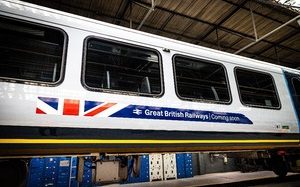SUPERNOVA – the evaluation tool
Posted: 30 July 2007 | | No comments yet
In early 2005, Global Railway Review’s sister publication, Eurotransport, published an article describing the main functions and the development of SUPERNOVA – the evaluation tool of ÖBB Passenger Transport Department. Since 2005, there have been some relevant improvements of SUPERNOVA which has enlarged widely the possibilities to use the model. This article will discuss those improvements and give an update on the SUPERNOVA evaluation tool.
In early 2005, Global Railway Review’s sister publication, Eurotransport, published an article describing the main functions and the development of SUPERNOVA – the evaluation tool of ÖBB Passenger Transport Department. Since 2005, there have been some relevant improvements of SUPERNOVA which has enlarged widely the possibilities to use the model. This article will discuss those improvements and give an update on the SUPERNOVA evaluation tool.
In early 2005, Global Railway Review’s sister publication, Eurotransport, published an article describing the main functions and the development of SUPERNOVA – the evaluation tool of ÖBB Passenger Transport Department. Since 2005, there have been some relevant improvements of SUPERNOVA which has enlarged widely the possibilities to use the model. This article will discuss those improvements and give an update on the SUPERNOVA evaluation tool.
As described in the article in Eurotransport Issue 2 2005, SUPERNOVA at that time was already a very detailed VISUM-based public transport model which covered the whole railway network and timetable and all regional bus services routed on a very fine road network. The model was intensively used to evaluate the effects of timetable changes (rail and connecting bus services) on the public transport demand. One effect of the intensive timetable evaluations under usage of SUPERNOVA was that the costumers of ÖBB PV AG in 2005 were more satisfied with the timetable than in the years before, although train kilometers were reduced compared with the previous years.
Due to the success of SUPERNOVA, additional resources could be used so that four planners (three at OBB PV AG and one at Postbus) had then six licenses available and usually at least one model run is started daily.
Caused by this intensive use, experience with and expectations on the model grew constantly. So a lot of ideas for improvements were discussed of which the following are already realised and some more are in the process of realisation.
Comprehensive and more detailed Transport Data Model
In the beginning, SUPERNOVA did not include air traffic. This was considered as a problem because air traffic – especially low cost air traffic – is one of the most important competitors to long distance rail services. As a consequence of this, air traffic volumes and travel times of the most important destinations and a modal split model rail/air traffic was included in SUPERNOVA. The traffic volumes were available for 2005 from the Austrian Statistical Office (Statistik Austria) and EUROSTAT. The travel times that represent the whole travel chain from door to door (corresponding to the railway and individual traffic travel times) were built up inhouse using the road network of SUPERNOVA.
At the end of this process, SUPERNOVA now can also compute a modal shift from air traffic to rail or vice versa following improving or reducing long distance railway services.
Furthermore, it turned out to be necessary to improve the level of detail especially in urban and suburban regions where communities were not accustomed to model the transport demand. In those areas, there were often a dense public transport network with a lot of stoppoints of which only a few were linked to the demand generating zones by access points.
The first idea to solve these problems was to use the counting parishes of Statistik Austria as the smallest available statistical unit. But this would have implicated at least a doubling of calculation times due to the bigger O-D-matrices. So we decided to use the approximately 3,200 counting areas as zones in SUPERNOVA which are the statistical units between counting parishes and communities. As a first step this helped to solve the problem in the urban and highly populated suburban areas.
On the other hand, this split made it necessary to include not only regional bus services but also urban transport services in the data model. This extension led to a number of approximately 100,000 daily public transport services in the model which now covers the whole range of public transport from the InterCityExpress (ICE) to urban metro, tram and bus lines.
Focus on cash effects
In the first stage of SUPERNOVA, the model was mostly used to compare different timetable concepts serving a line or an area. The measure of quality of the timetable concept was the difference of passenger kilometers to the reference case (usually the existing timetable). The costs and benefits in cash of those timetable concepts have been an external add on to the model results which was difficult work and a lot of time had to be spent on this. So we included a rather simplified but sufficient cash balance as an automatically generated model result which gives an immediate first glance of the cash effects of a timetable concept.
Integration of Forecast data
In the beginning of 2006, a big project of OBB was launched called ‘PLAN912’ – being the concept phase for a new nationwide periodic timetable that should be installed in Austria in two phases (phase 1 in december 2009, phase 2 at the end of 2012). At the same time, the main works on the Austrian transport forecast were finalised. This was a comprehensive study of the Austrian Ministry of Transport, Innovation and Technology (BMVIT) which covers the time period of 2002 to 2025. Out of this project, O-D-matrices for public and individual traffic for the years 2002, 2005 and five-year intervals up to 2025 became available for OBB PV AG.
To have the most suitable demand data basis for evaluating projects as the new periodic timetable this O-D-matrices were integrated in the model. This means the user can now chose a time horizon of the simulation. This option was in the meantime also used to evaluate the effects of longterm infrastructure projects, for example, the new Koralm railway between Graz and Klagenfurt. The predicted realisation of this project is by the year 2018.
A big advantage of this data-integration is that all long term evaluations are based on the official traffic forecast that is also used by all other big players in transport infrastructure policy in Austria, as the federal Ministry of Transport, Innovation and Technology (BMVIT) or the ASFINAG (Austrian highway operator). This data is also used by the other enterprises of the OBB trust, especially ÖBB Infrastruktur Betrieb AG (infrastructure operator) and Rail Cargo Austria.
The integration of forecast data and the automated cash balance, enables us also to use SUPERNOVA results directly as input data for the midterm business planning process of the OBB. With this approach, it is guaranteed that the results of traffic planning find their short way into the business planning what helps to harmonise those planning processes.
Outlook
SUPERNOVA-Bus
Using census areas as zones, SUPERNOVA proved to be sufficient for railway simulation – but it is not sufficient for modelling bus services – especially in provincial towns or rural areas. Austrians biggest bus operator Postbus AG which is affiliated by OBB PV AG, intends to use SUPERNOVA as its main demand simulation tool to further improve where necessary. This will be the final step to make SUPERNOVA an evaluation tool for all products of ÖBB PV AG (InterCity services, regional rail services and regional bus services).
The chosen method to do this step will not use classical statistical units anymore but stoppoint in combination with grid data information. This grid data includes the number of inhabitants and jobs. The grids are available up to 125 x 125 meters. The information about the number of pupils within each grid element was generated by a data merge in GIS-System.
In step 2, chosen existing stoppoints (approximately 7,000 out of a total of almost 35,000) were declared as model zones. The structural data of the grid elements were used as input data for the split of the existing zones into the new smaller zones. The split of the O-D-matrices was done differently for the purposes of commuter, school and other purposes confirming to the relevant structural data.
At the next step, the new zones were linked to the network with access links that were generated automatically and also optimised automatically (due to the number of about 15,000 access links a manual optimisation seems not to be possible anymore).
The result of this process will be a new zonal structure of SUPERNOVA with approximately 7,000 zones (compared with about 3,400 currently) which are optimised on the demand of ÖBB PV AG and Postbus AG as the main users of SUPERNOVA. Of course doubling the amount of zones will mean much longer calculation times but PTV as the author of VISUM transport modelling software that is used in SUPERNOVA promised to develop a software version that can handle multiple CPUs on a conventional Windows-PC. The aim is that the calculation time should not be higher than 20 hours per model run instead of the estimated 50 hours that need a model run with 7,000 zones now.
System Integration
As a consequence of the success of SUPERNOVA within the ÖBB and the Postbus AG, there is done at least one model run daily with peaks up to five parallel calculations. The manual input effort in VISUM for those model runs is considerable as there is up to now no interface neither between the planning system of the ÖBB (currently FBS) nor the future planning system MICROBUS of Postbus AG. But there is the idea to build up an interface that is based on the XML-standard for railways RAIL ML.
The advantage of this solution would be that there is only an export file of the timetable data produced by the planning system. This export file can then be used by SUPERNOVA but also by other systems e.g. COSWARE which is OBB PV vehicle –disposition-system or by the planning system of ÖBB Infrastruktur Betrieb AG the Austrian network operator.
The system integration is not only an efficiency booster for modelling due to reduction of manual input effort but also an important element of improving quality by avoiding errors and mistakes.
Conclusion
The vision of SUPERNOVA as a fully automated evaluation tool for all the products of OBB PV AG from InterCity to Bus services is almost realised but there is only one final step left to complete. But yet today SUPERNOVA helps ÖBB to realise the big projects that mark our way to one of Europe’s top railways.
About the author
Erwin Kastberger started his career at the Austrian Ministry of Transport, Innovation and Technology (BMVIT) in 1997. He was responsible for transport modelling and transport forecasts. Since 2005, he is the SUPERNOVA Project Officer at the ÖBB PV AG – the Passenger Division of the Austrian federal railways.







